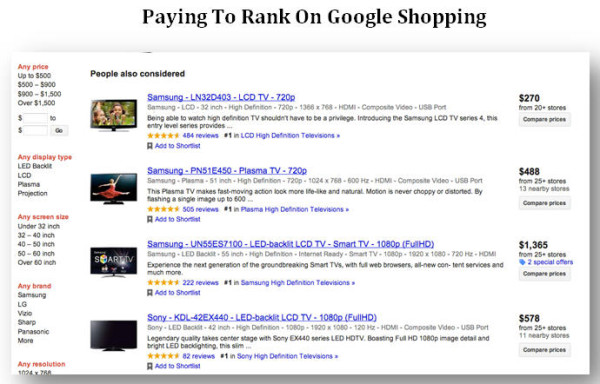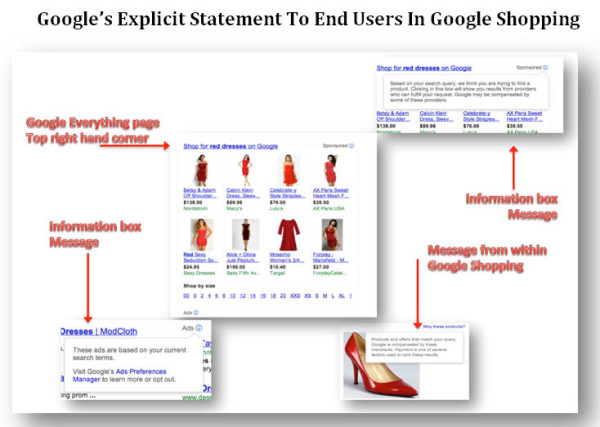How Leveraging Data Quality In Google Shopping Can Increase Product Sales
I’m sure many of you are aware that Ad Rank in Google AdWords is derived from the price you are willing to pay (bid price) multiplied by relevance (Quality Score), along with other factors. This is an extremely profitable model for Google as the majority of its income is derived from advertising revenue. Since Google […]
I’m sure many of you are aware that Ad Rank in Google AdWords is derived from the price you are willing to pay (bid price) multiplied by relevance (Quality Score), along with other factors. This is an extremely profitable model for Google as the majority of its income is derived from advertising revenue.
Since Google has a history of applying successful strategies to solve different problems, the use of Paid Inclusion was not unexpected when it introduced Google Shopping and Product Listing Ads (PLA).
Retailers advertising in Google Shopping should know the definition of Google Product Rank is a combination of “relevance and bid price” (similar to Ad Rank, also a combination of “relevance and bid price”). What this means is merchants must use clean data in their data feeds.
What Does Clean Data Mean?
Both Product Rank in Google Shopping and Ad Rank in Google AdWords are specified as relevance multiplied by bid price. Relevance, in both cases, is defined as quality.
In the case of Google Shopping, it means all data you give Google in the data feeds must be accurate, reliable and not conflict with any other informational sources or “signals” being sent out. The more your data is verified from multiple sources, the stronger signal it will give the search engines.
Products are listed on Google Shopping based on a paid component and a quality or relevancy component. A typical example of paid ranking results for HD TVs is depicted below. You must pay to rank, but having better data quality and richer data will, in many cases, offset the bid price in terms of ranking in Google Shopping.
What End Users See In The SERPs
Google also makes the above explicit (sort of), to the end users, should they think of clicking on the unobtrusive blue button (tiny info boxes on the “Google Everything Page,” where the ads are prominent with enhanced displays such as the one below, or on the just-as-unobtrusive blue statement, “Why these products,” in Google Shopping itself).
However, the user experience is far more engaging than before, and many of the enhanced displays are stunning.
The Importance Of Data Quality
What does this mean for SEO folks wanting to appear high in SERPs while minimizing their bid price? You must adhere to the Quality Score guidelines as well as Product Quality. It is crucial to adhere to quality standards — the richer your data and the better your Quality Scores and Product Scores, the less you pay for your ad. Data quality is key!
From a search engine perspective, this makes complete sense. Search engines do not like to be spammed, and neither do users. No-one likes being deceived in Google shopping when they select an item with one price on Google Shopping and then find the price is different or out of stock when they go to the item on the page! No-one likes dirty, noisy data — from the search engines themselves right down to the end users.
Google Shopping Clean Data Mandate
None of this is news, but if you put yourself in a search engines shoes, you can see they clearly must provide relevant results and create a great customer experience. If they can’t do this, they will lose market share. Clean, rich, well-attributed and relevant data is a must!
Paid inclusion is now a fact of life in Google Shopping, and Google made a simultaneous mandate requiring clean, relevant, rich data inputs to product feeds, data that is verifiable by cross referencing other sources. That means the following data must all be the same and in sync:
- Data on the webpage visible to humans
- On-page semantic markup
- Data in the product feed
Google’s mandate is strongly reminiscent of Semantic Web philosophy for dealing with data quality and provenance. As is the fact that Google uses some forms of Rich Snippets to expand its Knowledge Graph.
Paid Inclusion Good For Google & Merchants
Paid Inclusion has been a very effective strategy for Google, which had a strong fourth quarter, and was good for merchants as well. An example is listed below and derived from this report from Marin Software, published January 29, 2013. There are also many other reports indicating much better ROAS (Return on Ad Spend) with PLAs.
Marin Report Summary:
“… in the last year the click share of PLAs as a percent of total search clicks increased 210% as consumers increased their engagement with the ads, which appear as image results in Google Search and as product listings within Google Shopping. Google transitioned Google Shopping to a commercial model in October 2012, and the bet appears to be paying off with Marin finding that advertisers increased their share of search budgets directed towards PLAs by nearly 600% in the last quarter of 2012.”
What Does Rich Data Imply?
The easiest way to obtain a realistic understanding of data quality is to put yourself in your customers’ shoes. Customers want easily findable items and want to be able to quickly filter out SERPs they don’t need. They aren’t able to study the complexity of Data Quality, Provenance, Trust, Object Authority and the complexities of the Semantic Web .
However, adopting a basic KISS approach from a user’s perspective makes it very understandable. Think about your customers looking for black pumps.
If they go into Google Shopping, they can enter search queries that are filtered by the attribute, color property and also the size and silhouette. If merchants do not populate those fields in their data feed to Google, no matter how “clean” the data is, the items cannot possibly display in the SERPs.
Hence, it is essential to have rich, well-attributed information. Rich Data sends Rich Signals to the engines. Clearly illustrated in the image below are the filters on the left hand side. If merchants do not populate the color and other attributes, their items cannot show up in filtered search results.
You can markup many of these attributes with properties from schema.org on your product page. It is key, however, to put them in the product feed submitted to the major CSE’s (Comparison Shopping Engines). Richly-attributed data, therefore, increases your visibility in Search Engines.
Google Merchant Data Quality Specifications
Here, we can take a look at what Google stipulates as Data Quality. The first item in the diagram below states the submitted price on the feed must match the price on the webpage. We discussed the necessity for that already.
You also must absolutely have a valid UPC or other identifier. Another important requirement is that the Product Category must be accurate, or else the product will be suspended. There are several such examples that may or may not appear obvious to a naïve user.
Looking at the Google Merchant Data Quality issues depicted below, several things stand out. Clearly, no user wants to be frustrated with a price mismatch, or items suddenly unavailable, or going to a non-existent or off-the-subject landing page when making a purchase decision on the buy URL (destination page). You can read more about the importance of this and other details on the Google webmaster site.

Key Information
To summarize the takeaways from the information above:
- Ensure your data is clean and scrubbed, with the same signals being sent from all sources
- Ensure all necessary fields are populated, like UPC, brand, product category correct
- Ensure your landing pages are valid and product availability accurately specified
- Ensure that your data is fresh and frequently updated with new changes
- Ensure that your images are properly enhanced
- Ensure that you mark up the appropriate information for rich snippets, including product videos and product images, to send stronger signals
- Ensure markup of specific items in schema such as reviews and any other items that drive traffic and increase “trust” or authority (providing you have that information visible to human readers, too)
- Ensure that your sitemap is optimized and easy for the search engines to crawl, making use of the last mod feature in your site map
Special Note: The three universities: UCSD, UCI, UCLA, are coming together to create a Semantic Computer Consortium that leverages both academic and industrial resources. They will be at the next San Diego Semantic Web Meetup (no cost to attend) I am hosting on Thursday, February 21, at 6:00 pm at the UCSD Supercomputer Center. Anyone interested in hearing Prof Shlomo Dubnov and Prof Phillip Sheu elaborate on these plans is welcome to attend.
Contributing authors are invited to create content for Search Engine Land and are chosen for their expertise and contribution to the search community. Our contributors work under the oversight of the editorial staff and contributions are checked for quality and relevance to our readers. The opinions they express are their own.
Related stories




